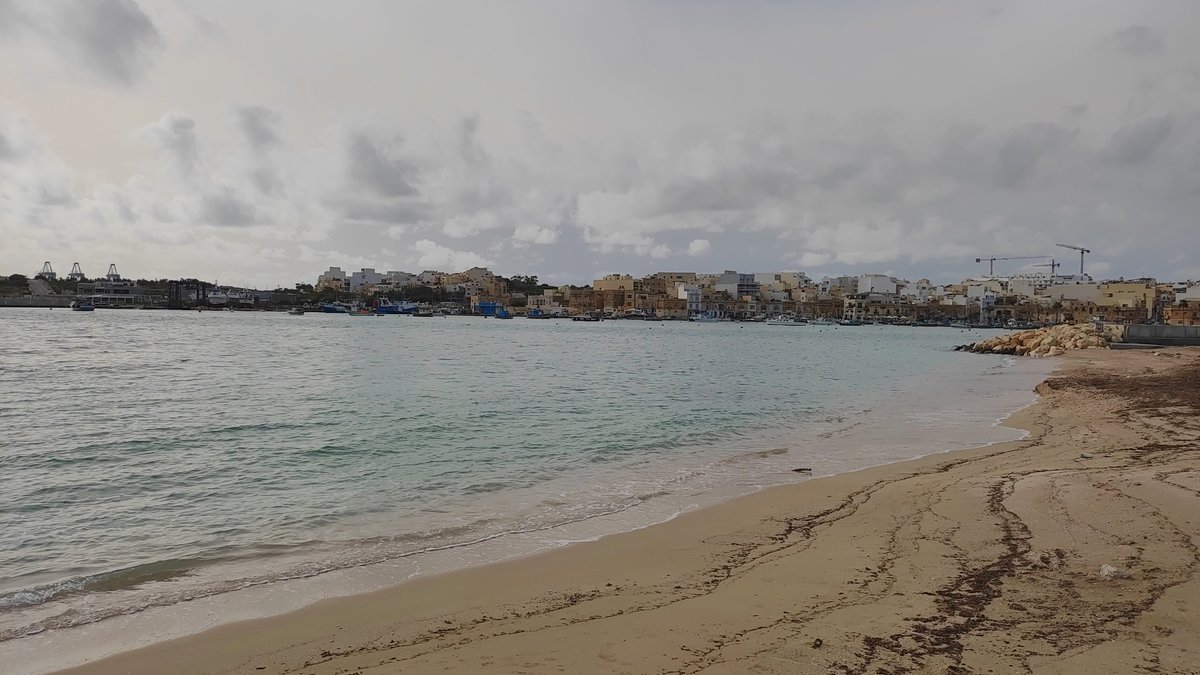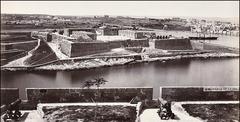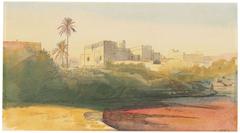
Visiting Marsaxlokk Harbour: Hours, Tickets, and Tips
Date: 18/07/2024
Introduction
Marsaxlokk Harbour, nestled in the southeastern part of Malta, is a captivating blend of history, culture, and natural beauty. This picturesque fishing village, known for its vibrant markets, traditional fishing boats, and scenic views, offers a unique glimpse into Malta’s rich maritime heritage. The name ‘Marsaxlokk’ originates from the Arabic word ‘Marsa’ meaning port and ‘xlokk’ referring to the southeast wind, highlighting its long-standing significance as a maritime hub. The harbour’s history dates back to antiquity, with evidence of Phoenician settlements around the 9th century BCE, making it one of the oldest continuously inhabited areas in Malta (Malta Heritage).
Throughout its history, Marsaxlokk has been a strategic port, utilized by various powers including the Romans, the Knights of St. John, and the British. Each era has left its mark on the harbour, from the remains of Roman villas to the fortifications built by the Knights of St. John to defend against Ottoman and pirate attacks. The Great Siege of Malta in 1565 is a particularly notable event, where the harbour played a pivotal role in the Knights’ successful defense against the Ottoman Empire (Great Siege of Malta).
In modern times, Marsaxlokk has evolved into a bustling fishing village and a popular tourist destination. The traditional Maltese fishing boats, known as ‘luzzus,’ with their distinctive bright colors and the eye of Osiris painted on the bow, are a testament to the area’s enduring maritime traditions. The Sunday fish market is a major draw for both locals and tourists, offering a wide variety of fresh seafood and local produce (Marsaxlokk Fish Market).
This comprehensive guide will take you through the history, cultural significance, and visitor information for Marsaxlokk Harbour. Whether you’re a history enthusiast, a food lover, or simply looking to explore Malta’s scenic beauty, Marsaxlokk has something to offer. From the historical Fort St. Lucian to the natural swimming spot at St. Peter’s Pool, you’ll find plenty of attractions to make your visit memorable.
Table of Contents
- Introduction
- Historical Significance
- Visitor Information
- Cultural Significance
- Preservation and Conservation
- Main Attractions
- Dining and Local Cuisine
- Events and Festivals
- Activities and Tours
- Shopping and Souvenirs
- Nature and Wildlife
- FAQ
- Conclusion
Historical Significance
Ancient Origins
Marsaxlokk Harbour, located in the southeastern part of Malta, has a rich history that dates back to antiquity. The name “Marsaxlokk” is derived from the Arabic word “Marsa,” meaning port, and “xlokk,” which refers to the southeast wind. This etymology underscores the harbour’s long-standing significance as a maritime hub. Archaeological evidence suggests that the area was inhabited as far back as the Phoenician period, around the 9th century BCE. The Phoenicians, renowned for their seafaring skills, established Marsaxlokk as a crucial trading post, facilitating commerce across the Mediterranean (Malta Heritage).
Roman Era
During the Roman era, Marsaxlokk continued to thrive as a significant port. The Romans recognized the strategic importance of the harbour, using it as a naval base and a point of entry for goods and people. The remains of Roman villas and artifacts, such as pottery and coins, have been discovered in the area, attesting to its historical importance. The harbour’s sheltered waters provided a safe anchorage for Roman ships, further cementing its role in regional trade and military operations (Roman Malta).
Medieval Period
In the medieval period, Marsaxlokk Harbour remained a vital maritime hub. The Knights of St. John, who ruled Malta from 1530 to 1798, fortified the area to protect against Ottoman and pirate attacks. Fort St. Lucian, built in 1610, is a prominent example of the Knights’ defensive architecture. The fort played a crucial role in safeguarding the harbour and the surrounding settlements from invasions. The Knights also utilized Marsaxlokk as a base for their naval fleet, further enhancing its strategic importance (Knights of Malta).
The Great Siege of Malta
One of the most significant events in Marsaxlokk’s history is the Great Siege of Malta in 1565. The Ottoman Empire, seeking to expand its influence in the Mediterranean, launched a massive assault on the island. Marsaxlokk Harbour was a focal point of the conflict, with Ottoman forces attempting to capture the strategic port. The Knights of St. John, along with Maltese civilians, mounted a fierce defense, ultimately repelling the invaders. The successful defense of Marsaxlokk and the island as a whole marked a turning point in the struggle between Christian Europe and the Ottoman Empire (Great Siege of Malta).
British Colonial Period
Marsaxlokk Harbour’s historical significance continued into the British colonial period, which began in 1800. The British recognized the harbour’s strategic value and developed it as a naval base. During World War II, Marsaxlokk played a crucial role in the defense of Malta. The harbour was a target for Axis bombing raids, but it also served as a vital supply point for Allied forces. The resilience of the Maltese people and the strategic importance of Marsaxlokk contributed to Malta being awarded the George Cross for bravery in 1942 (British Malta).
Modern Era
In the modern era, Marsaxlokk Harbour has evolved into a vibrant fishing village and a popular tourist destination. The traditional Maltese fishing boats, known as “luzzus,” are a distinctive feature of the harbour. These brightly painted boats, adorned with the eye of Osiris, reflect the area’s rich maritime heritage. The Marsaxlokk fish market, held every Sunday, is a major attraction, drawing visitors from around the island and beyond. The market offers a wide variety of fresh seafood, showcasing the harbour’s continued importance as a fishing hub (Marsaxlokk Fish Market).
Visitor Information
Marsaxlokk Harbour Visiting Hours
Marsaxlokk Harbour is accessible to visitors year-round. While the harbour itself doesn’t have restricted visiting hours, some attractions and the fish market operate on specific schedules. The Marsaxlokk fish market is open every Sunday from early morning until around 2 PM.
Marsaxlokk Harbour Tickets
Entry to Marsaxlokk Harbour is free. However, guided tours and some nearby attractions, such as Fort St. Lucian, may have ticketed entry. Check with local tour operators or the official websites for the latest information on tickets and pricing.
Travel Tips and Accessibility
- Getting There - Marsaxlokk is easily accessible by public transport from Valletta and other major towns in Malta. Buses run regularly, and there is ample parking for those driving.
- Accessibility - The harbour area is generally wheelchair accessible, but some historical sites may have limited access.
- Nearby Attractions - Don’t miss the nearby St. Peter’s Pool, a natural swimming spot, and the Gżira historical sites.
Cultural Significance
Marsaxlokk Harbour is not only significant for its historical and economic roles but also for its cultural heritage. The harbour and its surroundings are home to several important cultural sites. The Church of Our Lady of Pompei, built in the 19th century, is a focal point of the local community. The church’s annual feast, celebrated in August, is a vibrant event featuring processions, fireworks, and traditional music. This celebration reflects the deep-rooted religious and cultural traditions of the area (Our Lady of Pompei).
Preservation and Conservation
Efforts to preserve and conserve Marsaxlokk Harbour’s historical and cultural heritage are ongoing. The Maltese government, along with various heritage organizations, has implemented measures to protect the area’s historical sites and promote sustainable tourism. Initiatives such as the restoration of Fort St. Lucian and the conservation of traditional fishing practices aim to maintain the harbour’s unique character while ensuring its continued relevance in the modern era (Heritage Malta).
Main Attractions
Marsaxlokk Fish Market
One of the most iconic attractions at Marsaxlokk Harbour is the Marsaxlokk Fish Market, held every Sunday. This bustling market is a vibrant display of the local fishing culture, offering a wide variety of fresh seafood, including swordfish, tuna, and octopus. The market also features stalls selling local produce, crafts, and souvenirs. Visiting hours are from 6 AM to 2 PM. Experience the authentic atmosphere of a traditional Maltese fishing village and enjoy the sight of colorful ‘luzzu’ boats. (Visit Malta)
St. Peter’s Pool
Located a short distance from Marsaxlokk Harbour, St. Peter’s Pool is a natural swimming pool carved into the limestone rock. This stunning spot is popular among locals and tourists for its crystal-clear waters and excellent snorkeling opportunities. The pool is surrounded by flat rocks, perfect for sunbathing, and offers a serene escape from the bustling harbor. Access involves a bit of a hike, so appropriate footwear is recommended. (Malta Uncovered)
Marsaxlokk Parish Church
The Marsaxlokk Parish Church, dedicated to Our Lady of Pompei, is a significant landmark in the village. Built in the late 19th century, the church features a beautiful baroque façade and an ornate interior. It stands as a testament to the village’s deep-rooted Catholic faith and is a focal point during religious festivals, particularly the annual feast of Our Lady of Pompei celebrated in August. (Malta.com)
Fort Delimara
Fort Delimara, located on the Delimara Peninsula near Marsaxlokk, is a historic fortification built by the British in the 19th century to protect Marsaxlokk Bay from potential naval attacks. Although the fort is not fully open to the public due to its dilapidated state, its exterior can be admired from the surrounding area. The fort’s strategic location offers panoramic views of the bay and the Mediterranean Sea, making it a popular spot for photography enthusiasts. (Heritage Malta)
Xrobb l-Għaġin Nature Park
Xrobb l-Għaġin Nature Park and Sustainable Development Centre is a 155,000 square meter park located on the Delimara Peninsula. The park is dedicated to environmental conservation and sustainable development, featuring walking trails, picnic areas, and educational facilities. Visitors can explore the diverse flora and fauna, enjoy scenic views of the coastline, and learn about Malta’s efforts in environmental sustainability. (Nature Trust Malta)
Tas-Silġ Archaeological Site
Tas-Silġ is an important archaeological site located near Marsaxlokk. The site has revealed remains from various periods, including a prehistoric temple, a Punic-Roman sanctuary, and an early Christian basilica. Guided tours of the site are available, offering visitors a chance to explore the rich historical layers and understand the significance of this multi-period complex. (Heritage Malta)
Dining and Local Cuisine
Waterfront Dining
Marsaxlokk Harbour is renowned for its waterfront dining options, offering a variety of restaurants and cafes that serve fresh seafood and traditional Maltese cuisine. Dining by the harbor provides a picturesque setting with views of the fishing boats and the tranquil waters. Popular dishes include ‘lampuki’ pie, ‘aljotta,’ and ‘ħobż biż-żejt.’ Many restaurants source their seafood directly from the local fish market, ensuring a fresh and authentic dining experience. (Malta Travel Guide)
Events and Festivals
Traditional Festivals
Marsaxlokk hosts several traditional festivals throughout the year, reflecting the village’s cultural heritage and community spirit. The most notable is the annual Marsaxlokk Fish Festival, held in September, celebrating the local fishing industry with food stalls, live music, and cultural performances. Another significant event is the feast of Our Lady of Pompei, featuring religious processions, fireworks, and various festivities. (Malta Tourism Authority)
Activities and Tours
Boat Tours and Fishing Trips
Visitors to Marsaxlokk Harbour can enjoy boat tours and fishing trips, offering a unique perspective of the village and its surroundings. Boat tours typically include visits to nearby attractions such as St. Peter’s Pool, Delimara Point, and the Blue Grotto. Fishing trips provide an authentic experience of the local fishing traditions. (Marsaxlokk Boat Tours)
Diving and Snorkeling
The waters around Marsaxlokk Harbour are ideal for diving and snorkeling, with several dive sites offering diverse marine life and underwater landscapes. Popular dive sites include the Delimara Point and the Marsaxlokk Reef. Local dive centers offer equipment rental and guided dives for both beginners and experienced divers. (Dive Malta)
Shopping and Souvenirs
Local Handicrafts and Souvenirs
Marsaxlokk is known for its local handicrafts, including lacework, pottery, and traditional Maltese filigree jewelry. Visitors can find these items at the Sunday market and various shops around the harbor. These handcrafted items make for unique souvenirs and gifts, reflecting the island’s rich cultural heritage. (Malta Crafts)
Nature and Wildlife
Birdwatching at Salina Nature Reserve
Located near Marsaxlokk, the Salina Nature Reserve is a haven for birdwatchers, featuring salt pans that attract a variety of bird species, including flamingos, herons, and avocets. The reserve offers walking trails and observation points. The best time for birdwatching is during the migratory seasons in spring and autumn. (BirdLife Malta)
Marsaxlokk Bay
Marsaxlokk Bay itself is a picturesque and tranquil spot, perfect for a relaxing day by the water. The bay is sheltered and calm, making it ideal for swimming, kayaking, and paddleboarding. The clear waters and scenic surroundings provide a beautiful backdrop for water activities. (Malta Bay)
FAQ
Frequently Asked Questions
- What are the visiting hours for Marsaxlokk Fish Market?
- The Marsaxlokk Fish Market is open every Sunday from 6 AM to 2 PM.
- Are there any entrance fees for Fort Delimara?
- Fort Delimara is not fully open to the public, so there are no entrance fees.
- What is the best time for birdwatching at Salina Nature Reserve?
- The best time for birdwatching is during the migratory seasons in spring and autumn.
Conclusion
Marsaxlokk Harbour stands as a remarkable testament to Malta’s rich and diverse heritage. From its ancient Phoenician origins to its strategic importance during the Roman, medieval, and British colonial periods, Marsaxlokk has continually evolved while retaining its unique character. The harbour’s historical significance is complemented by its vibrant cultural traditions, such as the annual feast of Our Lady of Pompei and the Marsaxlokk Fish Festival, which offer visitors a glimpse into the local way of life (Our Lady of Pompei, Malta Tourism Authority).
Today, Marsaxlokk is not just a historical site but a living, breathing community that continues to thrive on its maritime heritage. The colorful ‘luzzus,’ bustling fish market, and waterfront dining experiences create a picturesque and authentic atmosphere that captivates all who visit. Efforts by the Maltese government and heritage organizations to preserve and promote the area’s historical and cultural assets ensure that Marsaxlokk remains a must-visit destination (Heritage Malta).
For those planning a trip to Malta, Marsaxlokk Harbour offers a rich tapestry of experiences. Whether you’re exploring the historical Fort Delimara, enjoying the natural beauty of St. Peter’s Pool, or simply soaking in the local culture at the fish market, Marsaxlokk provides a unique and enriching experience. As you plan your visit, remember to check for guided tours and special events to make the most of your time in this enchanting village. Stay connected with the latest updates and travel tips by downloading the Audiala mobile app and following us on social media.
References
- Malta Heritage, 2024, Heritage Malta https://heritagemalta.org
- Roman Malta, 2024, Roman Malta https://www.romanmalta.org
- Knights of Malta, 2024, Knights of Malta https://www.knightsofmalta.com
- Great Siege of Malta, 2024, Great Siege of Malta https://www.greatsiegeofmalta.com
- British Malta, 2024, British Malta https://www.britishmalta.org
- Marsaxlokk Fish Market, 2024, Marsaxlokk Fish Market https://www.marsaxlokkfishmarket.com
- Visit Malta, 2024, Visit Malta https://www.visitmalta.com/en/a/info/marsaxlokk
- Malta Uncovered, 2024, Malta Uncovered https://www.maltauncovered.com/attraction/st-peters-pool/
- Malta.com, 2024, Malta.com https://www.malta.com/en/attraction/churches/marsaxlokk-parish-church
- Heritage Malta, 2024, Heritage Malta https://heritagemalta.org/fort-delimara/
- Nature Trust Malta, 2024, Nature Trust Malta https://naturetrustmalta.org/xrobb-l-ghagin-nature-park/
- Heritage Malta, 2024, Heritage Malta https://heritagemalta.org/tas-silg/
- Malta Travel Guide, 2024, Malta Travel Guide https://www.maltatravelguide.com/marsaxlokk-restaurants
- Malta Tourism Authority, 2024, Malta Tourism Authority https://www.visitmalta.com/en/events
- Marsaxlokk Boat Tours, 2024, Marsaxlokk Boat Tours https://www.marsaxlokkboattours.com
- Dive Malta, 2024, Dive Malta https://www.divemalta.com/marsaxlokk-diving
- Malta Crafts, 2024, Malta Crafts https://www.maltacrafts.com
- BirdLife Malta, 2024, BirdLife Malta https://www.birdlifemalta.org/salina-nature-reserve
- Malta Bay, 2024, Malta Bay https://www.maltabay.com/marsaxlokk-bay
- Our Lady of Pompei, 2024, Our Lady of Pompei https://www.ourladyofpompei.org



